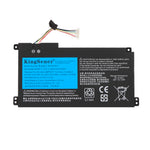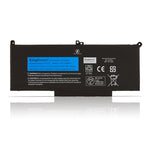You have no items in your shopping cart.
How to Tell If Your MacBook Needs a New Battery?

As a MacBook user, you've probably experienced the frustration of a battery that won't hold its charge or drains quickly. This is a common problem that many MacBook users face. It's no secret that MacBook batteries have a limited lifespan. Over time, batteries lose their ability to hold a charge, resulting in a decrease in battery life and the need for more frequent recharging.
But the good news is that if something happens to your MacBook battery, you can replace it yourself, and it's easier than you might expect.
Before proceeding, it is important to be aware of certain signs that indicate the need for a replacement of the MacBook battery. This will help us replace the battery at the appropriate time.
Signs that indicate your MacBook battery needs to be replaced.
(1)Battery service warning received
One of the clearest signs that your MacBook battery needs replacing is when you receive a battery service alert. It notifies you when your MacBook detects that the battery is no longer performing optimally. Of course, you can also check the battery status yourself by clicking on the battery level icon in the top menu bar. If it says "Replace ASAP," "Replace Now," or "Repair Battery," it's time to consider replacing the battery.
(2)Battery drains fast
If your MacBook's battery is draining quickly, even when you're not using any power-hungry applications, it could be an indication that the battery is nearing the end of its lifespan. When you first bought your MacBook, you probably enjoyed hours of battery life. But over time, if you find yourself experiencing a rapid drop in battery power after just a few minutes of use, it is a clear indication that the battery needs to be replaced. As a general rule of thumb, you may want to consider replacing the battery when the battery runtime drops to 25% of its original duration.
(3)Frequent unplanned downtime
Have you ever experienced a situation where your MacBook shuts down unexpectedly, even though it appears to have sufficient battery life? If this happens frequently, it could be a sign that the battery is no longer able to hold a charge effectively. Of course, unexpected shutdowns can also be caused by other factors, such as overheating or software issues. To determine if the MacBook battery is the cause, we can test it by plugging it in.
(4)MacBooks are prone to overheating.
Overheating is a common issue with electronic devices, including MacBooks. Overheating can occur for a number of reasons, including a faulty battery. If your MacBook tends to overheat quickly during day-to-day use and you are also experiencing the signs mentioned above, it is an indication that you need to consider replacing the battery.
However, it should be noted that overheating can also be caused by hardware or software issues. Therefore, it is advisable to eliminate other factors before concluding that the battery is defective.
Of course, in addition to the signs mentioned above that can indicate the need to replace your MacBook battery, we should also pay attention to the battery's charging cycle.

Apple MacBook A1496 laptop battery-Kingsener|BatteryMall
Generally speaking, the service life of a battery is measured in charge cycles. A charge cycle is the process of completely depleting the battery's power and then fully recharging it. As you use your MacBook, the number of charge cycles will increase, which will eventually lead to a decrease in battery performance.
We can determine when it is appropriate to replace your MacBook battery by checking the number of charge cycles the battery has undergone. This information can be found in the Power section of the Mac's System Information menu.
Apple provides a maximum cycle number for each MacBook model, which you can compare to the number of charge cycles used. If the number of charge cycles is close to the maximum, it is a good indication that your battery is nearing the end of its life and should be replaced as soon as possible.
How do I replace a MacBook battery?
Now that we have looked at the signs that indicate your MacBook battery needs replacing, it is time to learn how to replace it. Here is a step-by-step guide to assist you with this process.
1.Prepare and gather the necessary tools: Before you begin, make sure that you have all the tools required to replace the battery. These tools may vary depending on your MacBook model. You can find a comprehensive battery replacement kit from reputable sources such as iFixit or Apple.
2.Backup data: It's a good idea to back up your data before making any changes to your MacBook. This ensures that you do not lose any important files when replacing the battery.
3.Power off your MacBook: Ensure that you completely shut down your MacBook before proceeding to replace the battery. This ensures your safety and prevents any accidental damage to the device.
4.Prepare your workspace: Find a clean and well-lit work area for battery replacement.
5.Remove the MacBook back cover: Depending on your MacBook model, you may need to remove the back cover to access the battery. Follow the specific instructions for your MacBook model to safely remove it.
6.Disconnecting the battery: Once you have gained access to the battery, carefully disconnect it from the MacBook's logic board. Follow the instructions included with the battery replacement kit to ensure proper disconnection.
7.Replace the battery: Take a new battery from the replacement kit and connect it to the logic board of your MacBook. Make sure the connection is secure and properly aligned.
8.Reassemble your MacBook: After successfully replacing the battery, reassemble your MacBook by reversing the steps of disassembly. Be careful not to overtighten any screws and ensure that all components are properly aligned.
9.Power on and test: After reassembling your MacBook, power it on and check if the new battery is functioning properly. At the same time, we can also monitor its performance to ensure that it maintains sufficient power.
10.Dispose of old batteries: Remember to dispose of old batteries properly and avoid throwing them in the regular trash.
In conclusion, it is crucial to be aware of the signs indicating that your MacBook battery needs to be replaced in order to maintain optimal performance of your laptop. By closely monitoring the health of your battery, we can proactively address any issues and extend the overall lifespan of your MacBook.
Finally, if you want to learn more about batteries, please visit:BatteryMall.com/support.








